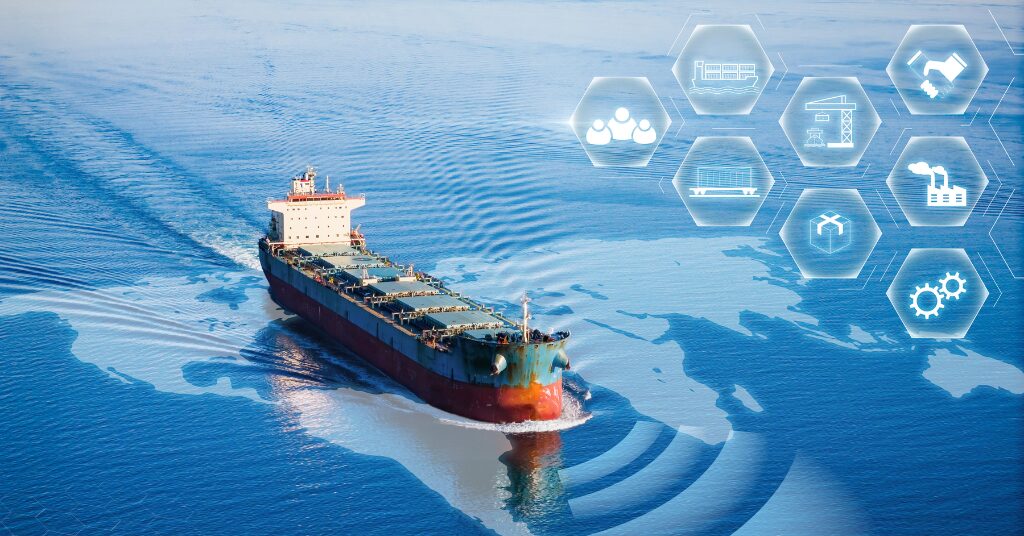April 19, 2025 - 9 minutes read

17 FAQs About Supply Chain Visibility
Supply chain visibility is the foundation for reliable operations. When orders, inventory, and shipments live in one shared view, companies can identify risks earlier, coordinate faster with partners, and give customers answers they can trust. This FAQ keeps it practical: what visibility is, how it shows up in daily work, and how to reduce surprises while improving service and cost control.
1. What is supply chain visibility, and why does it matter?
Supply chain visibility is a shared, real-time view of the full order-to-invoice lifecycle. It aligns operational events with financial checkpoints by unifying order status, inventory positions, transportation milestones, and the documents and charges that validate each step. Supply chain visibility solutions support these efforts, enabling organizations to identify disruptions and discrepancies and quickly address them in collaboration with other stakeholders.
2. What are the benefits of implementing a supply chain visibility solution?
A comprehensive and well-executed supply chain visibility platform improves both shipment execution and cost control in numerous ways:
- Improved OTIF performance and more reliable ETAs through earlier exception detection
- Fewer expedited charges and accessorial fees due to timely interventions
- Better inventory accuracy with less buffer stock
- Faster dispute resolution with a shared event and document history
- Better invoice accuracy, reducing discrepancies and disputes
- Clearer carrier and supplier performance evaluation for continuous improvement
3. How can real-time supply chain visibility improve customer satisfaction?
Real-time visibility gives customers confidence in the updates they receive and keeps their expectations aligned with reality. Accurate ETAs reflect actual conditions rather than static schedules, while early alerts allow service teams to manage expectations before a missed delivery becomes a bigger issue. Customers benefit from timely updates, fewer unexpected delays, and quicker recovery when disruptions occur—all of which strengthen trust and repeat business.
4. What is the difference between supply chain visibility and supply chain traceability?
Visibility and traceability are related but distinct. Visibility provides a live view of order and shipment progress, connecting physical movement with supporting data and costs. Traceability, on the other hand, tracks the origin and handling of a product throughout its lifecycle, often down to lot or batch level. Visibility improves execution and planning, while traceability ensures compliance with various sourcing regulations and overall quality control.
5. How does a lack of supply chain visibility impact business performance?
Limited supply chain visibility creates blind spots that ripple across operations and finance. The most common consequences include:
- Higher reliance on premium freight and safety stock to cover uncertainty
- Missed delivery commitments and increased chargebacks
- Longer invoice reconciliation cycles due to missing or conflicting data
- Weaker performance evaluation of carriers and suppliers
- Lost time as teams manually track updates instead of managing exceptions
These inefficiencies add unnecessary costs, erode customer confidence, and make it harder to scale reliably.
6. How do companies achieve end-to-end supply chain visibility?
End-to-end visibility in supply chains requires more than shipment tracking. Companies can achieve it by consolidating data from multiple systems, including ERP, WMS, TMS, and partner platforms, into a single, consistent view. This integration ensures that operational milestones, documents, and financial details are aligned from purchase order through invoice. Achieving true end-to-end visibility often means connecting data across regions, modes, and suppliers so all stakeholders are working from the same information rather than piecing it together across fragmented systems.
7. What role do IoT and AI play in enhancing supply chain visibility?
Emerging technologies like AI and IoT have been shaping supply chain visibility trends in recent years. IoT devices and sensors provide granular, real-time inputs that enrich visibility platforms, including location updates, temperature monitoring for sensitive goods, or equipment status. AI builds on that data to identify patterns, refine ETA predictions, and flag anomalies before they become costly problems. Together, IoT and AI reduce the lag between events and decisions, enabling supply chains to anticipate disruptions instead of reacting after the fact.
8. What are the essential features to look for in supply chain visibility software?
A robust supply chain visibility platform should cover the full order-to-invoice lifecycle. Important features and functionalities include:
- Real-time order and shipment tracking: Connects data across modes, suppliers, and carriers to provide accurate status updates. This should include order fulfillment updates from suppliers and in-transit tracking for inbound freight, as well as any outbound shipments.
- Exception management tools: Identify risks and exceptions early and provide automated alerts to support timely issue resolution.
- Integration capabilities: Links with ERP, WMS, TMS, and external partner systems to centralize data. Ideally, this also includes integrations for address verification, location APIs, GPS trackers, temperature sensors, flight status APIs, and ocean vessel trackers.
- Document management: Collects and centralizes shipping, customs, and financial documents to provide a single repository for all relevant stakeholders.
- Cost and invoice validation: Compares invoiced charges against quoted rates and actual service delivered to minimize invoice disputes with suppliers and providers.
- Analytics and reporting: Translates raw data into insights for critical supply chain KPIs to drive performance and process improvement.
9. What is a supply chain control tower, and how does it provide visibility?
A supply chain visibility control tower is a centralized hub that brings together data from across the network to simplify operational processes and shipment execution. Its value lies in connecting transactional shipment activity with inventory levels, inbound orders, and financial checkpoints. By linking this data in real time, the control tower delivers full supply chain visibility to give companies a comprehensive understanding of what is happening and how best to respond.
10. How does supply chain visibility help mitigate risks and disruptions?
Supply chain and logistics visibility reduces uncertainty by making potential problems more visible and easier to address. When delays, shortages, or compliance issues are alerted in real time, teams can act before they escalate into larger failures. Visibility also ensures every stakeholder is working from the same information, which shortens decision cycles and supports a more coordinated response. The result is less financial impact from disruptions and greater consistency in meeting service commitments.
11. How does supply chain visibility support sustainability and ESG goals?
Supply chain visibility helps organizations track and measure the factors that drive sustainability performance. With detailed, real-time data, companies can:
- Identify inefficient routes or modes that drive unnecessary emissions
- Validate supplier compliance with sourcing and labor regulations
- Monitor asset utilization to reduce waste and excess capacity
- Collect accurate documentation to support ESG reporting requirements
By aligning operational data with sustainability metrics, visibility enables companies to meet both regulatory obligations and their environmental and social commitments.
12. What is the relationship between supply chain visibility and inventory management?
Visibility and inventory management are closely connected. An accurate view of supplier orders, production schedules, and in-transit shipments improves demand forecasting and reduces the need for excess safety stock. It also highlights imbalances before they affect fulfillment, whether that means a shortage in one region or surplus in another. With better foresight into how goods are moving and where they are needed, companies can position inventory more effectively, cut carrying costs, and maintain stronger service levels.
13. How can supply chain visibility improve collaboration with suppliers and partners?
Visibility and collaboration reinforce each other. A centralized view of orders, shipments, and supporting documents gives every stakeholder the same starting point. With that foundation, suppliers can confirm demand and production schedules, carriers can better plan capacity, and customers receive timely, consistent updates. Document sharing plays a critical role here—when invoices, customs filings, and proof-of-delivery are tied directly to shipment events, conversations move away from reconciling paperwork and toward improving execution. In this way, visibility doesn’t just enable collaboration; collaboration is what makes visibility sustainable across the entire network.
14. What are the biggest challenges in achieving supply chain visibility?
Establishing true visibility is difficult because it depends on both the right technology and network-wide cooperation. Even companies with advanced systems run into obstacles that prevent a clear view of operations:
- Disconnected systems: Information lives in ERP, WMS, TMS, and freight forwarder systems that don’t easily connect. Without integration, data must be pieced together manually, which slows decision-making and increases the chance of errors.
- Fragmented data formats: Updates often arrive in emails, spreadsheets, and carrier portals that require separate logins. Consolidating these into a single view is resource-intensive and prone to gaps.
- Global and multimodal complexity: International shipments involve multiple carriers, customs agencies, and compliance requirements, each with different standards for sharing information. That creates blind spots when trying to maintain a single version of truth.
- Limited partner participation: Visibility relies on timely contributions from carriers, suppliers, and logistics providers. Some may be reluctant to share data, while others lack the technology to provide it consistently.
Overcoming these challenges requires not only system connectivity but also a strong commitment from partners to share data.
15. How do you measure the ROI of a supply chain visibility platform?
Return on investment (ROI) is measured by tracking how the supply chain visibility solution delivers cost savings, service improvements, and operational efficiency. Common metrics include:
- Freight spend savings: Earlier exception detection and better carrier comparisons reduce reliance on premium freight and lower overall transportation costs.
- OTIF and delivery performance: Real-time shipment updates improve schedule adherence and help hold carriers accountable.
- Routing guide compliance: Visibility into carrier performance and lane adherence ensures more shipments follow preferred, cost-effective routes.
- Bid response rate: Access to accurate shipment data improves procurement events by increasing carrier participation and competitiveness.
- Time saved through automation: Centralized tracking and alerts replace manual status checks and reduce “where is my order” inquiries, freeing up staff time.
- Invoice accuracy and chargebacks: Aligning shipment events with billing data minimizes disputes and accelerates reconciliation.
These measures show whether visibility is improving financial outcomes and service reliability in measurable ways.
16. How can small and medium-sized businesses (SMEs) afford supply chain visibility tools?
Many visibility solutions are now delivered as cloud-based services, which reduces upfront investment and ongoing maintenance costs. Flexible pricing models allow SMEs to start with essential features or limited shipment volumes and scale up as needs grow. The real affordability often comes from avoided costs, like fewer expediting fees, reduced administrative labor, and faster dispute resolution, which can outweigh the investment costs.
17. What is the first step to take to improve supply chain visibility?
The most effective first step is to assess where information gaps exist today. That may be missing updates from suppliers, fragmented carrier portals, or manual processes that delay communication. Identifying the biggest blind spots helps determine where a visibility initiative will have the most immediate impact. Starting small, with a clear problem to solve, creates early wins and builds support for broader adoption.
Taking the Next Step Toward Complete Supply Chain Visibility
Supply chain visibility is the foundation for reliable, cost-effective operations. If your organization is ready to close information gaps and gain a complete view from order to invoice, Agistix can help. Contact us to schedule a consultation and see how our comprehensive platform delivers the visibility and control in today’s supply chains demand.
